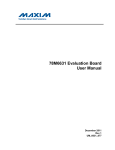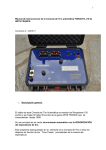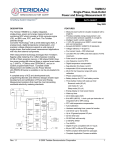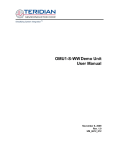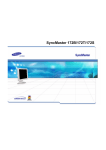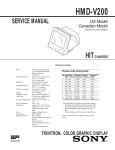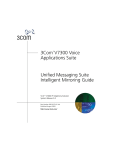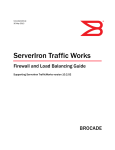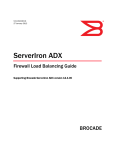Download OMU1-S-RF Demo Unit User Manual
Transcript
Simplifying System Integration TM OMU1-S-RF Demo Unit User Manual February 18, 2010 Rev. 1.2 UM_6612_016 78M6612 OMU1-S-RF Demo Unit User Manual UM_6612_016 © 2010 Teridian Semiconductor Corporation. All rights reserved. Teridian Semiconductor Corporation is a registered trademark of Teridian Semiconductor Corporation. Simplifying System Integration is a trademark of Teridian Semiconductor Corporation. Microsoft, Windows, Vista, and Excel are registered trademarks of Microsoft Corporation. ® CA51 is a trademark of Keil, An ARM Company. Signum Systems is a trademark of Signum Systems Corp. LabVIEW, NI and NI-VISA are trademarks of National Instruments. All other trademarks are the property of their respective owners. Teridian Semiconductor Corporation makes no warranty for the use of its products, other than expressly contained in the Company’s warranty detailed in the Teridian Semiconductor Corporation standard Terms and Conditions. The company assumes no responsibility for any errors which may appear in this document, reserves the right to change devices or specifications detailed herein at any time without notice and does not make any commitment to update the information contained herein. Accordingly, the reader is cautioned to verify that this document is current by comparing it to the latest version on http://www.teridian.com or by checking with your sales representative. Teridian Semiconductor Corp., 6440 Oak Canyon, Suite 100, Irvine, CA 92618 TEL (714) 508-8800, FAX (714) 508-8877, http://www.teridian.com 2 Rev. 1.2 UM_6612_016 78M6612 OMU1-S-RF Demo Unit User Manual Table of Contents 1 Introduction.................................................................................................................................... 5 1.1 Package Contents................................................................................................................. 5 1.2 System Requirements ........................................................................................................... 5 1.3 Safety and ESD Notes .......................................................................................................... 6 1.4 Firmware Demo Code Introduction ........................................................................................ 6 1.5 Testing the Demo Unit Prior to Shipping ................................................................................ 6 2 Installation ..................................................................................................................................... 7 2.1 USB Driver Installation .......................................................................................................... 7 2.2 Basic Connection Setup ........................................................................................................ 8 2.2.1 Attaching the USB-OPTO Daughter Board to the OMU1-S-RF ..................................... 9 2.2.2 Attaching the UART-ISO Daughter Board to the OMU1-S-RF .................................... 10 2.2.3 Attaching a Customer-Supplied COM Module to the OMU1-S-RF .............................. 11 2.3 Confirm COM Port Mapping ................................................................................................ 12 2.4 Verify Serial Connection to the PC ...................................................................................... 13 2.5 NI™ RunTime Installation ................................................................................................... 15 2.6 Install LabWindows™ XP Pro Update ................................................................................. 18 3 Operating the Dashboard GUI ..................................................................................................... 21 3.1 Port Selection ..................................................................................................................... 21 3.2 Creating a Measurement Data Log File ............................................................................... 22 3.3 Selecting the Power Display Parameter............................................................................... 22 3.4 Selecting the Display Scales ............................................................................................... 23 3.5 Resetting the Min and Max Indicators to Their Current Values ............................................. 23 3.6 Begin Tracking Minimum and Maximum Conditions............................................................. 24 3.7 Selecting Outlet1 ................................................................................................................ 24 3.8 Selecting Wide Band or Narrow Band Measurement ........................................................... 25 3.9 Selecting the Sample Interval .............................................................................................. 25 3.10 Alarm Status ....................................................................................................................... 25 3.11 Neutral Voltage Alarm ......................................................................................................... 26 3.12 Line Frequency ................................................................................................................... 26 3.13 Accumulated Energy Usage and Expense Tracking ............................................................ 27 3.14 Displaying Narrowband and Wideband Values Simultaneously............................................ 27 3.15 Using the Parameter Graph ................................................................................................ 28 3.16 Setting Alarm Status Thresholds ......................................................................................... 28 3.17 Relay Configuration Controls............................................................................................... 29 3.18 Log File Import to Excel ...................................................................................................... 30 4 Schematics, Bill of Materials and PCB Layouts ......................................................................... 33 4.1 OMU1-S-RF Demo Board Schematics ................................................................................ 33 4.2 OMU1-S-RF Demo Board Bill of Materials ........................................................................... 35 4.3 OMU1-S-RF Board PCB Layouts ........................................................................................ 37 4.4 USB Daughter Board Schematic ......................................................................................... 39 4.5 UART-ISO Daughter Board Schematic................................................................................ 40 5 Ordering Information ................................................................................................................... 41 6 Included Documentation ............................................................................................................. 41 7 Contact Information ..................................................................................................................... 41 Revision History .................................................................................................................................. 41 Rev. 1.2 3 78M6612 OMU1-S-RF Demo Unit User Manual UM_6612_016 Figures Figure 1: OMU1-S-RF Application Diagram.............................................................................................. 8 Figure 2: HyperTerminal Window with the Disconnect Button ................................................................. 14 Figure 3: OMU1-S-RF Demo Board Electrical Schematic (1 of 2) ........................................................... 33 Figure 4: OMU1-S-RF Demo Board Electrical Schematic (2 of 2) ........................................................... 34 Figure 5: 78M6612 Evaluation Board PCB Top View.............................................................................. 37 Figure 6: 78M6612 Evaluation Board PCB Bottom View......................................................................... 37 Figure 7: 78M6612 Evaluation Board Copper Top View ......................................................................... 38 Figure 8: 78M6612 Evaluation Board Copper Bottom View .................................................................... 38 Figure 9: USB Daughter Board Electrical Schematic .............................................................................. 39 Figure 10: UART-ISO Daughter Board Electrical Schematic ................................................................... 40 Tables Table 1: COM Port Setup Parameters .................................................................................................... 13 Table 2: OMU1-S-RF Demo Board Bill of Materials ................................................................................ 35 4 Rev. 1.2 UM_6612_016 78M6612 OMU1-S-RF Demo Unit User Manual 1 Introduction The Teridian Outlet Measurement Unit, Model OMU1-S-RF, is a low-cost power monitor utilizing the Teridian 78M6612 SOC. The Teridian 78M6612 monitors the AC line voltages and load current, and controls switching of an internal load relay. The embedded firmware calculates the RMS line voltage and RMS load current, watts, VA, VAR and power factor. The real time data is transmitted to a PC for display in a Windows based Graphical User Interface (GUI). The 78M6612’s UART interface is used as the communications link to a customer supplied RF module for the OMU1-S-RF. The OMU1-S-RF evaluation kit is intended to be used for development and integration of a separate communications interface. Included with the OMU1-S-RF is a pair of isolated daughter boards and a Windows based Graphical User Interface (GUI) for simplified access to the following measurement data and controls: • • • • • • • • • • • • Power, current, voltage and power factor indicator dials Adjustable display scales Minimum and peak parameter tracking Selectable strip chart display format Narrow-band versus Wide-band measurement Selectable sample size averaging Accumulated energy usage and expense tracking Line frequency Alarm indicators Programmable Alarm thresholds Internal load relay (16A) control Data log to file Alternatively, the user can directly query the device with the command set using HyperTerminal and the provided 6612_OMU_S2_URT_V1_13 Firmware Description Document. 1.1 Package Contents The OMU1-S-RF Demo Kit includes: • • • • • OMU1-S-RF module USB A/B cable USB-OPTO Daughter Board UART-ISO Daughter Board CD with Software and Documentation 1.2 System Requirements The OMU1-S-RF GUI requires use of a PC with the following features: • • PC (1 GHz, 1 GB) with Microsoft® Windows XP or Win2000, equipped with USB port. Minimum 1024 x 768 video display resolution. Rev. 1.2 5 78M6612 OMU1-S-RF Demo Unit User Manual UM_6612_016 1.3 Safety and ESD Notes EXERCISE CAUTION WHEN LIVE AC VOLTAGES ARE PRESENT! Standard ESD precautions must be taken when handling electronic equipment. The OMU1-S-RF contains ESD protected interfaces. Do not connect test equipment, ICE emulators or external development boards directly to the OMU-RF hardware. Damage to the OMU1-S-RF and external equipment will occur due to the 78M6612’s “high side” reference topology. The 78M6612’s V3P3 (i.e. “high side”) is connected directly to Neutral (Earth Ground) creating a ground reference disparity with any properly grounded external equipment. Always use the provided UART-ISO daughter board for connecting external development boards. Contact Teridian for instructions on connecting other types of test equipment. 1.4 Firmware Demo Code Introduction The Firmware Demo Code provides the following features: • • Basic energy measurement data such as Watts, Volts, current, VAR, VA, phase angle, power factor, accumulated energy, frequency, date/time, and various alarm statuses. Control of alarm thresholds, calibration coefficients, temperature compensation, etc. There are two means to facilitate performance evaluation between the user at the PC host and the firmware code in the OMU1-S-RF Demo Unit: • • The Graphical User Interface (GUI). This document describes the installation and use of the Windows based GUI. The Command Line Interface (CLI) via HyperTerminal or comparable terminal emulator on a different operating system. For information about the CLI, see the 6612_OMU_S2_URT_V1_13 Firmware Description Document. The OMU1-S-RF Demo Unit is shipped with Demo Code Revision 1.13 or later loaded in the 78M6612 chip and included on the CD. The code revision can be verified by entering the command >i via the command line interface. Firmware for the Demo Unit can be updated using either the Teridian TFP1 or an in-circuit emulator such as the Signum Systems™ ADM-51 (http://www.signum.com/Signum.htm). The board components and firmware settings are designed to operate with the following nominal AC electrical ranges: Voltage Current Line Frequency 110-240 VAC 10 mA – 20A 46-64 Hz 1.5 Testing the Demo Unit Prior to Shipping Before every OMU1-S-RF Demo Unit is shipped, the following procedures have been performed at the factory: • • 6 Full Calibration – Precise energy source equipment is used to calibrate the current and voltage. The temperature is also calibrated at the same time. Accuracy Test – This “bench” level test ensures the energy measurement accuracy is within +/-0.5%. Rev. 1.2 UM_6612_016 78M6612 OMU1-S-RF Demo Unit User Manual 2 Installation 2.1 USB Driver Installation This evaluation kit includes an optically isolated USB adaptor board for serial communications with a PC. The FTDI USB controller IC FT232RL performs the USB functions. The FTDI Windows driver presents a virtual COM port for enabling serial communications. Control of the OMU1-S-RF module can be managed using either a terminal emulation program or using the supplied Windows Dashboard GUI. The FTDI Windows driver is a certified driver for Windows 2000 and XP. 1. Upon attaching the OMU1-S-RF module to the PC, the Found New Hardware Wizard automatically launches and installs the appropriate driver files. If your PC does not find the FTDI driver files on its local hard disk drive, locate and reference the FTDI USB Driver and Utilities subdirectory on the CD. The FT232RL controller is powered from the USB cable and is active even when no AC power is applied to the OMU1-S-RF. Notes: If an older FTDI driver has been previously installed, it is recommended to remove the older version before installing this newer FTDI driver. Execute the ftdiClean.exe utility from the FTDI USB Driver and Utilities subdirectory. For FTDI driver support on other operating systems, please check FTDI’s website at (http://www.ftdichip.com/FTDrivers.htm). Rev. 1.2 7 78M6612 OMU1-S-RF Demo Unit User Manual UM_6612_016 2.2 Basic Connection Setup Figure 1 shows the basic connections of the OMU1-S-RF with the external equipment. The OMU1-S-RF is powered by an internal switch-mode power supply (SMPS) module and is not powered through the USB cable. The USB connection only provides the communications link between the host PC and the OMU1-S-RF. USB Isolation Windows PC with GUI USB Controller The OMU1-S-RF has two NEMA connectors, one male and one female. The male connector is for inlet and the female connector is for outlet. The male connector is connected to a wall outlet or a power strip. The female connector connects to the load to be measured. 120/240V Single Phase AC Source UART OMU1-S-RF USB Adaptor 3.3V 12V Wireless Development Kit UART Isolation SMPS 3V3 Reg Current Shunt UART UART Isolator ICE 6612 UART Voltage Divider Voltage Divider Status LEDs Windows PC With GUI Wireless or PLC Module Wireless or PLC Module UART (not included) Load Under Test Figure 1: OMU1-S-RF Application Diagram 8 Rev. 1.2 UM_6612_016 78M6612 OMU1-S-RF Demo Unit User Manual 2.2.1 Attaching the USB-OPTO Daughter Board to the OMU1-S-RF Attach the USB-OPTO daughter board to the OMU1-S-RF for use with the supplied GUI. This hardware interface provides an easy way to explore the 78M6612 firmware features. The USB daughter board incorporates signal isolators to protect the connected PC. Attach the USB-OPTO daughter board to the OMU1-S-RF’s UART cable as shown. Take note of the cable’s Red wire (+V) with regards to the daughter board’s connector pin assignments. Do not attach external equipment to the OMU1-S-RF when using the USB-OPTO. If it is necessary to attach test equipment, contact Teridian for instructions. Rev. 1.2 9 78M6612 OMU1-S-RF Demo Unit User Manual UM_6612_016 2.2.2 Attaching the UART-ISO Daughter Board to the OMU1-S-RF Attach the UART-ISO daughter board to the OMU1-S-RF for use with external development boards. External development boards are customer-supplied hardware incorporating their communications module and debug interfaces. Their debug interfaces are typically RS-232 or USB cables with direct connections to a PC. The daughter board incorporates signal isolators to protect the external development board hardware and its attached PC. Attach the UART-ISO daughter board to the OMU1-S-RF’s UART cable as shown. Take note of the cable’s Red wire (+V) with regards to the daughter board’s connector pin assignments. The UART-ISO daughter board does not supply power to the attached external development board. The female connector J2 is provided for attaching the external development board. The J2 pin assignments are as follows: Pin 1 Pin 2 Pin 3 Pin 4 +3.3V or +5V (input, required to power signal isolator) TX (78M6612 output, Vout dependent on voltage at pin 1) RX (78M6612 input, Vin threshold dependent on voltage at pin 1) GND The UART-ISO daughter board does not support 1.8V signal levels. Do not attach external equipment to the OMU1-S-RF when using the UART-ISO. If it is necessary to attach test equipment, contact Teridian for instructions. 10 Rev. 1.2 UM_6612_016 78M6612 OMU1-S-RF Demo Unit User Manual 2.2.3 Attaching a Customer-Supplied COM Module to the OMU1-S-RF A fully isolated external communications board (i.e. Wireless or PLC module) may be attached to the OMU1-S-RF’s UART cable without using the UART-ISO daughter board. The OMU1-S-RF UART cable supplies 100 ma max at +3.3 V. The OMU1-S-RF UART cable pin assignments are as follows: Pin 1 Pin 2 Pin 3 Pin 4 Red Blue Yellow Black +3.3V (output, 100ma max) TX (78M6612 output, Vout: +3.3V/0V) RX (78M6612 input, Vin: +3.3V/0V) GND The OMU1-S-RF UART cable does not support 1.8V signal levels. Do not attach external equipment to the OMU1-S-RF when using the UART cable. If it is necessary to attach test equipment, contact Teridian for instructions. Rev. 1.2 11 78M6612 OMU1-S-RF Demo Unit User Manual UM_6612_016 2.3 Confirm COM Port Mapping 1. Launch the Control Panel and click on the System icon. 2. The System Properties screen appears. Click on the Hardware tab. Click on Device Manager. Under Ports (COM & LPT), look for the USB Serial Port assignment. 3. Take note of the COM port assignment for the USB Serial Port. OMU1 COM Port: 12 Rev. 1.2 UM_6612_016 78M6612 OMU1-S-RF Demo Unit User Manual 2.4 Verify Serial Connection to the PC After connecting the USB cable from the OMU1-S-RF to the host PC, start the HyperTerminal application (or another suitable communication program) and create a session using the communication parameters show in Table 1. Table 1: COM Port Setup Parameters Setup Parameter 78M6612 Port speed (baud) 38400 Data bits Parity Stop bits Flow control 8 None 1 Xon/Xoff HyperTerminal can be found in Windows by selecting Start All Programs Accessories Communications HyperTerminal. The connection parameters are configured by selecting File Properties. The New Connection Properties menu appears. Select COM Port Select the appropriate COM port and click Configure. The COMn Properties menu appears. Rev. 1.2 13 78M6612 OMU1-S-RF Demo Unit User Manual UM_6612_016 Note that port parameters can only be adjusted when the connection is not active. It may be necessary to click the Disconnect Button (shown in Figure 2) to disconnect the port. Disconnect Figure 2: HyperTerminal Window with the Disconnect Button 14 Rev. 1.2 UM_6612_016 78M6612 OMU1-S-RF Demo Unit User Manual 2.5 NI™ RunTime Installation The GUI Dashboard program is created using National Instruments LabVIEW™. The NI RunTime Engine must be installed first before launching the Dashboard GUI. 1. Open the LabWindows XP Installer directory on the CD. 2. Execute the setup.exe file. Rev. 1.2 15 78M6612 OMU1-S-RF Demo Unit User Manual UM_6612_016 3. Select the destination directory. 4. Accept the License Agreement. 16 Rev. 1.2 UM_6612_016 78M6612 OMU1-S-RF Demo Unit User Manual 5. Start the installation. 6. When the installation is complete, restart your computer. Rev. 1.2 17 78M6612 OMU1-S-RF Demo Unit User Manual UM_6612_016 2.6 Install LabWindows™ XP Pro Update Do not install LabWindows XP Pro Update on Win2k. 1. Launch the LabWindows XP Pro VISA Update.exe installation file on the CD. 2. Un-zip the file to the proper folder. 18 Rev. 1.2 UM_6612_016 78M6612 OMU1-S-RF Demo Unit User Manual 3. Start the installation. 4. Select the proper destination directories. 5. Accept the License Agreements. Rev. 1.2 19 78M6612 OMU1-S-RF Demo Unit User Manual UM_6612_016 6. The following screen appears. Click Next. 7. Click Finish. 8. Copy the OMU GUI V3p0.exe application file from the CD to your PC. 9. Restart your computer. 20 Rev. 1.2 UM_6612_016 78M6612 OMU1-S-RF Demo Unit User Manual 3 Operating the Dashboard GUI Start the Dashboard Program using launching Teridian OMU GUI V3p0.exe. 3.1 Port Selection The COM port must be selected before data can be received from the OMU1. Select the appropriate COM port assignment previously defined on the Device Manager screen in Section 2.2. COM Port Selection The Run and Stop buttons are located above the Teridian logo. Run Stop If the OMU1 is disconnected from the USB cable, close and restart the GUI to re-establish the USB COM port connection. Rev. 1.2 21 78M6612 OMU1-S-RF Demo Unit User Manual UM_6612_016 3.2 Creating a Measurement Data Log File Upon clicking the Run button, a File Write dialog box appears. The GUI stores retrieved measurement data to a file for post processing. Enter the desired subdirectory and file name. Click OK to launch the main GUI display. The measurement data is stored as text characters delimited by commas. Click the Stop button to close the text file and end the data logging function. New data log files are created wherever the Run button is clicked. The data log capture automatically stops after 12 hours. 12 hours of data results in a 12 MB file. To import the data log file into Excel, see Section 4.19. 3.3 Selecting the Power Display Parameter Using the Watts Selection menu under OMU Control Modes, select Watt, VA or VAR as the power display parameter. Watt, VA, or VAR menu Real power is the time average of the instantaneous product of voltage and current (Watt). Apparent power is the product of rms (root mean square) volts and rms amps (VA, volt-amps). Reactive power is the time average of the instantaneous product of the voltage and current, with current phase shifted 90 degrees (VAR, voltamps reactive). 22 Rev. 1.2 UM_6612_016 78M6612 OMU1-S-RF Demo Unit User Manual 3.4 Selecting the Display Scales The range of values displayed in the Watts dial, the Current (rms) dial, and the Voltage (rms) dial can be changed. Use the Voltage Range, Watts Range and Current Range menus under OMU Control Modes to select the display scales for Watts, Current, and Voltage. Scale for Voltage, Watts and Current 3.5 Resetting the Min and Max Indicators to Their Current Values The Reset Min/Max button sets the Minimum and Maximum display values to the current conditions. Press the Reset Min/Max button to store the measured values in the first row of the display into the second row (the Min values) and the third row (the Max values). First Row – Current Conditions Second & Third Rows – Minimum & Maximum Reset Min/Max Rev. 1.2 23 78M6612 OMU1-S-RF Demo Unit User Manual UM_6612_016 3.6 Begin Tracking Minimum and Maximum Conditions To begin tracking minimum and maximum conditions as they occur, click the Start Min/Max button. Minimum values will display in the second row and maximum values will display in the third row. Minimum Values Maximum Values Start Min/Max 3.7 Selecting Outlet1 The GUI has provisions to display two loads: Outlet1 and Outlet2. However, the OMU1-S-RF module contains only one load socket. Select Outlet1 for use with the OMU1-S-RF module. All Outlet2 power and current measurement displays show “0.00” due to the missing load circuit. Similarly, all Totals measurement displays mirror the Outlet1 results. Select Outlet1 24 Rev. 1.2 UM_6612_016 78M6612 OMU1-S-RF Demo Unit User Manual 3.8 Selecting Wide Band or Narrow Band Measurement The GUI provides for two measurement algorithm options. The Wide Band measurement method is optimal for measuring power from equipment with switching power supplies. The Narrow Band method works well with conventional loads. All measurement displays, dials and graph are updated with the appropriate data based on the Wide Band / Narrow Band selection. Wide Band or Narrow Band 3.9 Selecting the Sample Interval Sample Interval provides a menu of sample sizes for display averaging. The 1 Second setting updates the display with every sample once a second. The 5 Seconds setting averages 5 samples and updates the display every 5 seconds, etc. Interval Cnt provides an index for the next display update. For example, if Sample Interval is set to 5 Seconds, Interval Cnt will count from 1 to 5. Sample Interval Interval Cnt 3.10 Alarm Status The Alarm Status indicator turns red if any Alarm Status Threshold is exceeded. See Section 4.16 for more information. Rev. 1.2 25 78M6612 OMU1-S-RF Demo Unit User Manual 3.11 UM_6612_016 Neutral Voltage Alarm The Neutral Voltage Alarm turns red when the Line and Neutral wires are reversed and Earth GND is connected. Earth GND must be connected for this function to operate properly. Neutral Voltage Alarm Neutral Line Line Neutral Earth GND Earth GND 3.12 Line Frequency The Line Frequency indicator displays the existing line frequency. Frequency is displayed with 0.1 Hz resolution. “???” is displayed when no voltage is present. Frequency Reading 26 Rev. 1.2 UM_6612_016 3.13 78M6612 OMU1-S-RF Demo Unit User Manual Accumulated Energy Usage and Expense Tracking If a Cost per KWh value is entered, the OMU1-S-RF will calculate and display the accumulated energy cost. • • • • Slide the vertical scroll bar down to display the Present Cost/KWh, which shows the currently stored value in the OMU1-S-RF module. Enter a new value, such as 10, in the box below and click the Write KWh Cost button to save this updated cost information. Do not hit the keyboard’s Enter key after typing in the new numeric value. The Total Energy and Total Cost windows (under Duplex Totals) update automatically with the new information. The accumulated Total Energy and Total Cost windows are reset by clicking the Reset Min/Max button. Vertical Scroll Bar Enter Cost per KWh Total Energy Total Cost 3.14 Displaying Narrowband and Wideband Values Simultaneously Slide the horizontal scroll bar to the right to view both sets of data. Horizontal Scroll Bar Rev. 1.2 27 78M6612 OMU1-S-RF Demo Unit User Manual 3.15 UM_6612_016 Using the Parameter Graph Use the Parameter Graph to display sample size averages for a specified parameter and time scale. • • Select the parameter to chart using the Select Parameter menu. Select the time scale using the Select Time Scale menu. Select Parameter Menu Select Time Scale Menu 3.16 Setting Alarm Status Thresholds The OMU1 can trip an alarm whenever a specified minimum or maximum temperature, frequency, voltage, maximum current narrowband, maximum current wideband, power factor narrowband and power factor wideband. When the specified value is exceeded, the corresponding Alarm Status Indicator turns red. Also, the Alarm Status on the Dashboard turns red. • To the left of the main control panel are the Alarm Status Indicators. Use the horizontal scroll bar to bring the indicators into view. Alarm Status Indicators 28 Rev. 1.2 UM_6612_016 • 78M6612 OMU1-S-RF Demo Unit User Manual Below the Alarm Status Indicators are the current threshold values and data entry boxes to change the OMU1 event counter threshold values. Enter Value(s) • • Enter a new value and click on the respective Write button to save the new value to the OMU1-S-RF. Do not press the keyboard’s Enter key after typing in a new numeric value. 3.17 Relay Configuration Controls The internal load relay defaults to the off condition (load not powered) upon power-on or restart of the GUI. The relay control button is located in the lower right hand corner of the main GUI control panel. A relay status indicator is located to the left of the control button. The relay status indicator and all other GUI indicators experience a 1-2 second update delay after clicking the relay control button. Relay Control Button Rev. 1.2 29 78M6612 OMU1-S-RF Demo Unit User Manual UM_6612_016 Advanced relay controls can be found by scrolling down to the bottom of the GUI. These are reserved for future use. Do not use with the OMU1-S-RF. Relay Configuration 3.18 Log File Import to Excel The OMU1-S-RF measurement data can be graphed and post processed by importing its text data into various analysis programs. The column data is separated by commas. The first dozen lines contain OMU1-S-RF informational data. The measurement data follows with each 1-second sample stored as a separate line item. To import the log data into Excel, begin by clicking on the Excel File/Open option from the main menu. 30 Rev. 1.2 UM_6612_016 78M6612 OMU1-S-RF Demo Unit User Manual Change the Files of type to all Files(*.*). Then find your sub-directory and select your data log file. No changes required on the next dialog box, click Next. Uncheck Tab and then check Comma. Click Next to proceed. Rev. 1.2 31 78M6612 OMU1-S-RF Demo Unit User Manual UM_6612_016 Select Text for Column data format. Click Finish to complete importing log file data. The log file text data can now be parsed using standard Excel formulas. 32 Rev. 1.2 UM_6612_016 78M6612 OMU1-S-RF Demo Unit User Manual 4 Schematics, Bill of Materials and PCB Layouts This section includes the schematics, bill of materials and PCB layouts for the OMU1-S-RF Demo Board, and the schematics for the USB Daughter Board and the UART-ISO Daughter Board. -12V VR1 BP5045A SIP10BP MS 755-BP5045A Non-Isolated SMPS 8 + GND is a virtual ground -VIN1 -VIN2 -VIN3 -VIN4 SD GND C15 C16 220uF 25V lo imp 0.015uF UUDB 0603 MS 647-UUD1E221MNL MS 80-C0603C153K3R 5 -VOUT R21 16.9K 1% 0603 1 VS R22 10.0K 1% 0603 4 GND C17 4.7uF 25V 1206P 511-1503-1-ND 2 3 6 7 VR2 UCC284 SOIC8 MS 595-UCC284DP-ADJ 10 GND 3 2 1 -12V HVDC 4 C13 0.1uF 450V C330 MS 80-C330C104KCR + + C12 10uF 450V XRL450B MS 140-XRL450V10-RC JP2 Weco Tst SIP100P3 L2 L1 1 MS 5160-2867 Male NEMA 5-15 Case rear panel upper half 8 R20 10 1/2W 1210W MS 660-RK73H2ETTD10R0F D1 1A 400V SMB MS 621-S1GB-F 6 L1 1000uH 0.5A 18R105C MS 580-18R105C + JP1 Weco Tst SIP100P2 1 2 OMU1-S-RF Demo Board Schematics C18 0.1UF 0603 + 4.1 C3 10uF 25V 1812 478-1762-1-ND V3P3 V3P3 is Neutral/Earth Gnd All things ref erenced to V3P3 f or 78M6612 V3P3 connected to NEUTRAL f or Saf ety due to SMA GND shield Note: SMA GND shield is -3.3V relativ e to Neutral (Earth GND) STAR POINT 1 V3P3 R1 0.004 1% 2.5W 2512P MS 66-ULR25R004FLFTR J2 CON1 SIPW1 NEUTRAL White 1 Sensor connection at shunt pads V3P3 C21 0.1UF 0603 NUETV R3 750, 0.1% C19 1000pF 0603 0603 V3P3A 57 53 C2 0.1UF 0603 GND IA C24 0.1UF 0603 IB R4 16.9K 1% 0603 56 V1 IB 59 R25 750, 0.1% 0603 J3 CON1 SIPW1 C4 100pF 0603 GND LINEE Black LINEC 1 2 C20 4.7uF 25V 1206P 511-1503-1-ND C22 0.1UF 0603 C5 1000pF 0603 R8 750 0.1% 0603 P750Y CT-ND 54 55 VREF VA V2P5 C7 27pF 0603 XOUT J8 CON1 SIPW1 J9 CON1 SIPW1 U1A 78M6612-68QFN R10 R9 1M 0.1% 1M 0.1% 1206W 1206W MS 660-RN732BTTD1004B25 1 52 VOLTAGE INPUTS GNDA Q1 R24 PNP 500ma 30V 1K SOT23T 0603 MS 610-CMPTA63 1 50 V3P3 RELAY 1 J4 CON1 SIPW1 58 VB R23 10K 0603 7 8 + 3 4 RL1 16A 12V SPDT Low Prof ile ALZ 255-1446-ND 5 6 -12V R5 20.0K, 1% 0603 GND R6 R7 1M 0.1% 1M 0.1% 1206W 1206W MS 660-RN732BTTD1004B25 1 V1 XIN 64 XOUT Y1 32.768KHz ABS25 535-9166-1-ND XIN 62 4 CURRENT INPUT C1 1000pF 0603 GND 1 J1 CON1 SIPW1 C9 27pF 0603 GND EGND EGNDV 1 Green R11 750 0.1% 0603 P750Y CT-ND C8 1000pF 0603 C23 0.1UF 0603 MS 5160-49-2BK Female NEMA 5-15 Case lower edge f acing down Figure 3: OMU1-S-RF Demo Board Electrical Schematic (1 of 2) Rev. 1.2 33 78M6612 OMU1-S-RF Demo Unit User Manual UM_6612_016 V3P3 V3P3 Reset Switch EVQ-PJX05M Panasonic 1K 1K 1000pF R12 NC 0603 SW1 NC EP11 49 VBAT GND RESET V3P3 SEG0 SEG1 SEG2 SEG3 SEG4 SEG5 SEG6 SEG7 SEG8 SEG9 SEG10 SEG11 SEG12 SEG13 SEG14 SEG15 SEG16 SEG17 SEG18 SEG29/DIO9 SEG30/DIO10 SEG31/DIO11 SEG34/DIO14 SEG35/DIO15 SEG36/DIO16 SEG37/DIO17 SEG19/DIO19 SEG40/DIO20 SEG41/DIO21 51 RESET C10 NC 0603 R13 0 0603 GND GND V3P3 J6 ICE SIP100P6 1 2 3 4 5 6 ICE inputs become LCD seg driv ers when ICEE low RXTX TCLK ERST 2 67 66 ICEEN C14 1000pF 0603 38 E_RXTX/SEG38 E_TCLK/SEG33 E_RST/SEG32 COM0 COM1 COM2 COM3 ICE_E R17 330 0603 GND SEG28/DIO8 TP2 TP TPWW TP3 TP TPWW 1 CKTST TMUX 9 4 CKTEST/SEG19 TMUXOUT DIO3 R19 100 0603 UART1TX UART1RX SEG26/DIO6 R14 470 0603 43 FAULTB 39 40 READY B ACTIVEB 5 1 R15 470 0603 LED3 GREEN LED100 MS 606-4300H7LC R16 470 0603 6 48 41 TP8 TP TPWW R18 10K 0603 TP1 Wh SIP100P2 SEG26/DIO06 V3P3 PULSE OUTPUT TX RX 1 SEG27/DIO7 42 RELAY 1 RELAY 1 1 TP6 TP TPWW TP7 TP TPWW 1 3 60 OPT_TX/DIO2 OPT_RX/DIO1 1 78M6612-68QFN GNDD1 GNND2 TP4 TP TPWW TP5 TP TPWW 14 15 16 17 LED2 Y ELLOW LED100 MS 606-4300H5LC 1 V3P3 GND LED1 RED LED100 MS 606-4300H1LC GND3 TEST 65 63 GND 1 61 J5 DEBUG SIP100P4 1 2 3 4 V3P3 GND SEG24/DIO4 SEG25/DIO5 Connect V3P3 to C17-1(+) 18 19 20 7 11 12 25 26 27 28 29 30 31 32 33 34 35 36 37 44 45 46 21 22 23 13 24 47 68 1 2 Optional SW1 R12 R13 C10 V3P3D C11 0.1uF 0603 V3P3SYS 8 10 U1B GND Figure 4: OMU1-S-RF Demo Board Electrical Schematic (2 of 2) 34 Rev. 1.2 UM_6612_016 4.2 78M6612 OMU1-S-RF Demo Unit User Manual OMU1-S-RF Demo Board Bill of Materials Table 2: OMU1-S-RF Demo Board Bill of Materials Item Qty Reference Part PCB Footprint Digi-Key/Mouser Part Number Supplier Part Number Manufacturer 1 5 C1,C5,C8,C14,C19 1000pF 0603 MS 581-06035C102J 06035C102JAT2A AVX 2 7 0.1µF 0603 MS 80-C0603C104K5RAL C0603C104K5RALTU KEMET 3 4 5 6 7 8 9 10 1 1 2 1 1 1 1 2 C2,C11,C18,C21, C22,C23,C24 C3 C4 C7,C9 C12 C13 C15 C16 C17,C20 10µF, 25V 100pF 27pF 10µF 450V 0.1µF 500V 220µF 25V lo imp 0.015µF 4.7µF 25V 1812 0603 0603 XRL450B C330 UUDB 0603 1206P 478-1762-1-ND MS 581-06035A101J MS 581-06035A270J MS 140-XRL450V10-RC MS 80-C330C104KCR MS 647-UUD1E221MNL MS 80-C0603C153K3R 511-1503-1-ND TPSC106K025R0500 06035A101JAT2A 06035A270JAT2A 140-XRL450V10-RC C330C104KCR5TA UUD1E221MNL1GS C0603C153K3RACTU TCTAL1E475M8R 11 12 13 14 15 16 17 18 19 1 1 1 1 1 1 1 1 1 D1 JP1 JP2 J6 LED1 LED2 LED3 L1 Q1 1A 400V Weco Tst Weco Tst ICE RED YELLOW GREEN 1000uH 0.5A PNP 500ma 30V SMB SIP100P2,M SIP100P3,M SIP100P6,M,R/A LED100 LED100 LED100 18R105C SOT23T MS 621-S1GB-F MS 571-1032392 MS 571-1032393 MS 538-22-12-2061 MS 606-4300H1LC MS 606-4300H7LC MS 606-4300H5LC MS 580-18R105C MS 610-CMPTA63 S1GB-13-F 103239-2 103239-3 22-12-2061 4300H1LC 4300H7LC 4300H5LC 18R105C CMPTA63 20 21 22 23 24 25 1 1 4 2 1 4 RL1 R1 R3,R8,R11,R25 R4,R21 R5 R6,R7,R9,R10 16A 12V SPDT 0.004 1% 2.5W 750 0.1% 16.9K 1% 20.0K, 1% 1M 0.1% ALZ 2512P 0603 0603 0603 1206W ALZ12F12 ULR25R004FLFTR ERA-3YEB751V 302-16.9K-RC 302-20K-RC RN732BTTD1004B25 26 1 R13 0 0603 255-1446-ND MS 66-ULR25R004FLFTR P750YCT-ND MS 302-16.9K-RC MS 302-20K-RC MS 660RN732BTTD1004B25 MS 301-0-RC AVX AVX AVX Xicon KEMET Nichicon KEMET ROHM Semiconductor Diodes Inc. Tyco/AMP Tyco/AMP Molex Chicago Miniature Chicago Miniature Chicago Miniature Murata Central Semiconductor Panasonic IRC Panasonic Xicon Xicon KOA Speer 301-0-RC Xicon Rev. 1.2 35 78M6612 OMU1-S-RF Demo Unit User Manual UM_6612_016 Digi-Key/Mouser Part Number MS 301-470-RC MS 301-330-RC MS 301-10K-RC MS 301-100-RC MS 660RK73H2ETTD10R0 MS 302-10K-RC MS 301-1.0K-RC MS 538-22-12-2021 Supplier Part Number 301-470-RC 301-330-RC 301-10K-RC 301-100-RC RK73H2ETTD10R0F SIP10BP MS 755-BP 5045A BP5045A SOIC8 AB525 MS 595-UCC284DP-ADJ 535-9166-1-ND UCC284DP-ADJ ABS25-32.768KHZ-T Item 27 28 29 30 31 Qty 3 1 2 1 1 Reference R14,R15,R16 R17 R18,R23 R19 R20 Part 470 330 10K 100 10 1/2W PCB Footprint 0603 0603 0603 0603 1210W 32 33 34 35 1 1 1 1 R22 R24 TP1 U1 10.0K 1% 1K Wh 78M6612-68QFN 0603 0603 SIP100P2, M QFN 68 36 1 VR1 BP5045A 37 38 1 1 VR2 Y1 UCC284 32.768kHz 36 302-10K-RC 301-1.0K-RC 22-12-2021 78M6612-IM Manufacturer Xicon Xicon Xicon Xicon KOA Speer Xicon Xicon MOLEX Teridian Semiconductor ROHM Semiconductor Texas Instruments Abracon Rev. 1.2 UM_6612_016 78M6612 OMU1-S-RF Demo Unit User Manual 4.3 OMU1-S-RF Board PCB Layouts Figure 5: 78M6612 Evaluation Board PCB Top View Rev. 1.2 Figure 6: 78M6612 Evaluation Board PCB Bottom View 37 78M6612 OMU1-S-RF Demo Unit User Manual Figure 7: 78M6612 Evaluation Board Copper Top View 38 UM_6612_016 Figure 8: 78M6612 Evaluation Board Copper Bottom View Rev. 1.2 UM_6612_016 4.4 78M6612 OMU1-S-RF Demo Unit User Manual USB Daughter Board Schematic TP1 USB3V TPWW TP2 HOST3V TPWW 1 TP3 USB5V TPWW 1 1 USB3V 1 2 3 4 5 6 1 19 USBDM USBDP 15 14 18 5 12 13 25 29 23 C2 4.7uF 1206P 1.5M A/B White Cable Mouser 571-1487588-2 27 28 16 RXD TXD USBDM USBDP RTS CTS DTR DSR DCD RI RESETB NC1 NC2 NC3 NC4 NC5 NC6 OSCI OSCO 3V3OUT C3 0.1uF 0603 1 CBUS0 CBUS1 CBUS2 CBUS3 CBUS4 24 4 17 20 26 TP5 USBGND TPWW VCCIO VCC AGND GND1 GND2 GND3 TEST J1 USB-B MS 806-KUSBVX-BSIN-W USBBV USB5V 2 30 USBTX USBRX 32 8 31 6 7 3 1 2 3 4 V1 V2 VOA VIA VIB VOB ND1 G2 8 7 6 5 U2 ADUM3201 ADUM3201 ADUM3201ARZ-ND V3P3 UART1TX UART1RX R1 10K 0603 HOSTGND 1 2 3 4 J2 DEBUG SIP100P4 Female 1 TP4 HOSTGND TPWW C1 4.7uF 1206P 22 21 10 11 9 U1 FT232QFN32 MS 895-FT232RQ FTQFN32 USBGND Figure 9: USB Daughter Board Electrical Schematic Rev. 1.2 39 78M6612 OMU1-S-RF Demo Unit User Manual 4.5 UM_6612_016 UART-ISO Daughter Board Schematic Figure 10: UART-ISO Daughter Board Electrical Schematic 40 Rev. 1.2 UM_6612_016 OMU1-S-RF Demo Unit User Manual 5 Ordering Information Part Description Order Number 78M6612 Wireless/PLC Outlet Measurement Demo Unit 78M6612-DB/OMU-RF 6 Included Documentation The following 78M6612 documents are included on the CD: 78M6612 Data Sheet 6612_OMU_S2_URT_V1_13 Firmware Description Document 7 Contact Information For more information about Teridian Semiconductor products or to check the availability of the 78M6612, contact us at: http://www.teridian.com/contact-us/ 6440 Oak Canyon Road Suite 100 Irvine, CA 92618-5201 Telephone: (714) 508-8800 FAX: (714) 508-8878 Revision History Revision Date Description 1.0 11/6/2009 First publication. 1.1 2/1/2010 Updated the schematics in Figure 3 and Figure 4. Updated the bill of materials in Table 2. 1.2 2/18/2010 In Table 2, added Supplier Part Number and Manufacturer columns to the Bill of Materials. Rev. 1.2 41












































